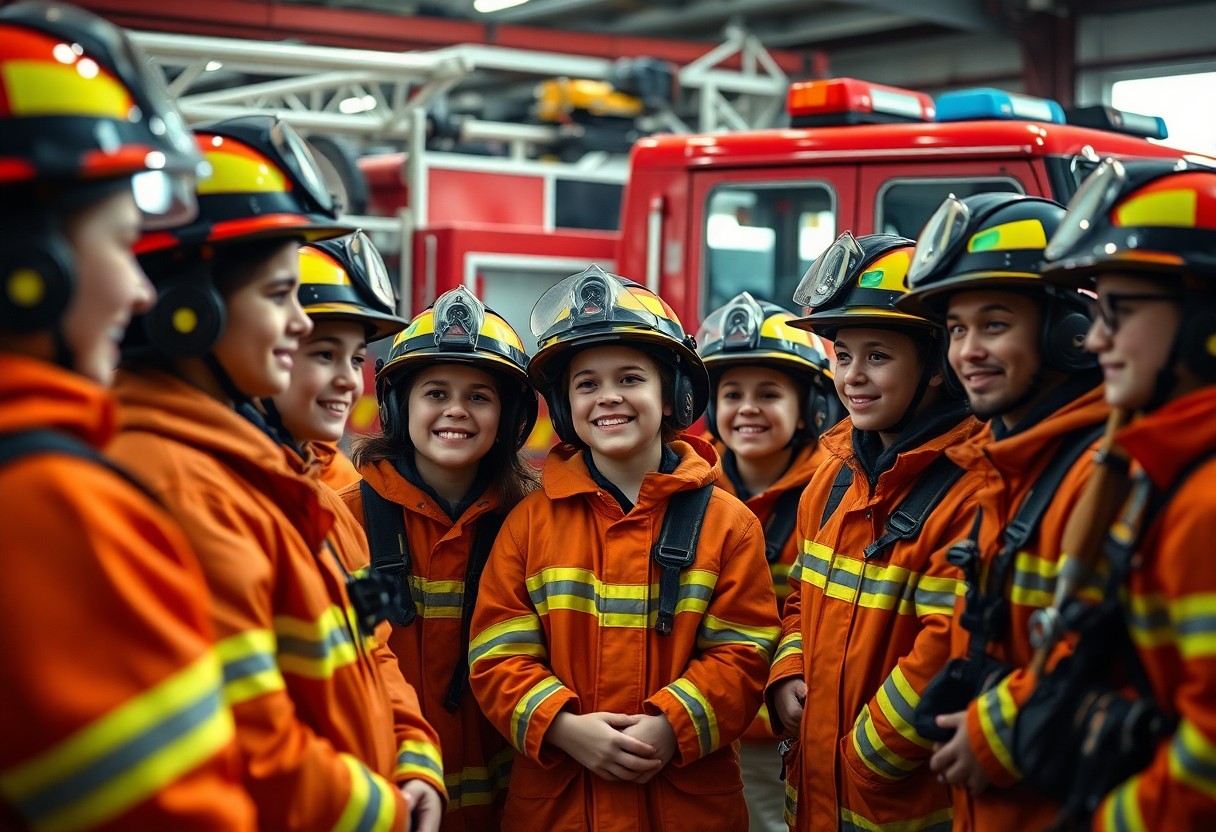You have the opportunity to inspire the next generation of firefighters and instill a sense of duty within your community. Engaging youth in firefighting not only helps to build a strong foundation for volunteer departments but also provides young individuals with imperative skills and valuable experience. In this guide, you’ll explore effective strategies and practical activities designed to captivate young minds and encourage their involvement in firefighting, ensuring a safer future for everyone.
Understanding the Importance of Youth Engagement
Your involvement in youth engagement is vital for the sustainability and growth of your volunteer fire department. By actively engaging younger generations, you foster a sense of community, build vital skills, and ensure a legacy of preparedness and commitment to firefighting. Engaging youth not only enhances team dynamics but also bridges the gap between generations, creating a more robust and diversified department ready to face future challenges.
Benefits of Involving Youth in Firefighting
There’s an array of benefits to involving youth in firefighting, from enhancing their leadership skills to fostering a strong sense of responsibility. By participating in fire safety drills and community outreach, youth develop qualities such as teamwork and resilience. These experiences not only prepare them for emergencies but also instill a desire to serve their communities, which can lead to a lifelong commitment to firefighting and public safety.
Addressing Common Misconceptions
Firefighting is often perceived as a highly dangerous pursuit that is unsuitable for young people. However, this assumption overlooks the critical learning experiences and safety measures integrated into youth training programs. This safe and structured environment is designed to educate youth about fire safety and emergency response while providing age-appropriate challenges that encourage personal growth. Engaging youth in firefighting equips them with life-saving skills and a comprehensive understanding of safety protocols, ultimately breaking down misconceptions surrounding their involvement.
How to Create an Engaging Curriculum
Any volunteer fire department looking to engage youth effectively needs to develop a curriculum that resonates with their interests while imparting imperative skills. Focus on creating a structure that balances theoretical knowledge with practical applications. Incorporate modern learning tools and techniques to ensure that your curriculum captures and holds the attention of younger participants.
Key Components of an Effective Curriculum
Some of the key components you should include in your curriculum are well-defined learning objectives, interactive lessons, and continuous feedback mechanisms. Each section should relate to real-world applications to keep participants engaged and eager to learn. Fostering a sense of community and teamwork among youths will enhance their experience and growth.
Incorporating Hands-On Activities
Components of your curriculum must include a variety of engaging, hands-on activities that allow youth to experience firefighting firsthand. Such activities not only stimulate interest but also teach valuable skills that theoretical lessons alone cannot provide. By developing scenarios that mimic real-life challenges, you can provide your young participants with an impactful learning experience.
The integration of hands-on activities is paramount for enhancing your curriculum. Practical exercises such as fire drills, equipment handling, and simulated rescue operations not only make learning fun but also equip youth with imperative firefighting skills. These activities foster teamwork and build confidence, ensuring that they feel comfortable facing high-stakes situations. Additionally, you can involve local experts for demonstrations, allowing participants to learn from real-life firefighters while reinforcing the importance of safety and responsibility in emergency situations.
Tips for Attracting Youth to Firefighting Programs
Even the most dedicated firefighting programs can struggle to connect with youth. To successfully engage them, consider the following strategies:
- Highlight the importance of community service
- Showcase the exciting opportunities in firefighting
- Promote mentorship from experienced firefighters
- Organize fun, interactive events
Assume that the enthusiasm for adventure and service will resonate with young individuals seeking purpose.
Marketing Strategies for Recruitment
Programs to recruit youth should be targeted and engaging. Use compelling messaging that communicates the rewards of becoming a volunteer firefighter. Create promotional materials that feature exciting visuals and real stories from current firefighters. Engage with local schools and community organizations to spread the word about your program.
Utilizing Social Media and Digital Platforms
Social media is an effective tool for showcasing the dynamic nature of firefighting. Use platforms like Instagram, Facebook, and TikTok to share photos, videos, and stories that highlight the action, teamwork, and community impact involved in firefighting. Develop a consistent posting schedule to maintain interest and engage youth through interactive content.
Tips for leveraging social media effectively include utilizing eye-catching visuals and engaging with your audience through comments and messages. Create appealing content that resonates with youth, such as virtual tours, behind-the-scenes videos, or live Q&A sessions. Encourage young people to share their experiences with the program on their own platforms, fostering a sense of community and excitement around the firefighting world. Highlight success stories of young volunteers to inspire others to join and showcase the positive impact they can have while pursuing their passion for firefighting.
Factors to Consider When Designing Programs
Unlike conventional educational settings, engaging youth in firefighting programs requires a tailored approach. You should consider the following factors to enhance participation:
- Age: Tailor activities to different age groups.
- Interests: Incorporate themes that resonate with youth.
- Accessibility: Ensure programs are easy to attend and participate in.
- Safety: Address safety concerns in activities.
- Community Support: Involve local organizations and leaders.
The success of your programs depends on these considerations.
Understanding the Interests of Youth
Youth engagement is more effective when programs align with their interests and passions. By identifying what captivates young people in your community, you can design activities that are both fun and educational, creating a genuine connection to firefighting and enhancing their learning experience.
Assessing Community Needs and Resources
Programs must be designed with an understanding of community dynamics, including available resources and unique local needs. You should conduct assessments to identify gaps in fire safety education and available facilities, ensuring your initiatives are not only well-received but also effectively respond to community demands.
It is important to actively gather data on your community’s needs regarding fire safety and education. Engaging local stakeholders will help pinpoint critical resources, such as funding, facilities, and equipment. Additionally, assessing the existing knowledge base of youth in your community can inform customized programs that highlight fire safety practices and invite widespread participation. By aligning your offerings with these insights, you’ll foster a stronger connection and greater involvement from young people in your firefighting initiatives.
How to Foster a Supportive Environment
All volunteer fire departments can benefit from creating a supportive atmosphere that encourages youth engagement. By nurturing a culture of respect and belonging, you will help young individuals feel valued and motivated to participate in firefighting activities. Focus on open communication and collaboration among members, which fosters trust and allows youth to express their ideas and concerns freely. Investing in such an environment will ultimately lead to a stronger, more effective firefighting team.
Mentorship and Role Models in Firefighting
There’s a significant impact that mentorship can have on youth in firefighting. When experienced firefighters take the time to guide and support younger members, they not only share valuable skills but also inspire confidence and leadership. This relationship can cultivate personal growth and help you navigate the demands of the profession, providing a sense of purpose and direction.
Building a Sense of Community
Firefighting offers an incredible opportunity to build a close-knit community. In your department, you can create bonding experiences through training exercises, social events, and volunteer activities. Engaging youth not only nurtures their passion for firefighting but also strengthens the connections among members. This shared purpose encourages collaboration, commitment, and a collective identity. Ultimately, fostering a supportive community demonstrates that you’re all working towards a common goal: protecting your community and supporting one another.
This teamwork is crucial, as firefighting requires quick decisions and effective communication during emergencies. A sense of community can enhance your department’s resilience in facing challenges. By holding regular events and encouraging youth participation, you can create lasting friendships and camaraderie that inspires members. These connections can motivate young individuals to excel and take pride in their role as firefighters, leading to greater retention and success within your department.
Evaluating and Adapting Your Program
For effective engagement of youth in firefighting, it’s necessary to regularly evaluate and adapt your program. This involves analyzing the success of current initiatives, identifying areas for improvement, and incorporating new ideas that resonate with young participants. By staying flexible and responsive to their needs, you can create a dynamic environment that fosters participation and enthusiasm.
Gathering Feedback from Participants
An efficient way to understand the effectiveness of your program is by actively gathering feedback from participants. You can use surveys, informal discussions, or suggestion boxes to collect their opinions. This input will provide valuable insight into what elements are working well and what modifications could enhance the overall experience.
Making Continuous Improvements
Improvements should be an ongoing process that fosters the best experiences for youth within your firefighting program. Engaging with participants and incorporating their feedback will help you identify trends and preferences that you can leverage to keep the program exciting and relevant.
Continuous assessment and adaptation will allow you to create a program that evolves as the interests of youth change. You should set specific goals for improvement based on the feedback received, focusing on enhancing the safety, accessibility, and engagement aspects of your program. By keeping your curriculum fresh and dynamic, you ensure that your program remains a positive influence in their lives, motivating them to remain involved and develop a passion for firefighting.
Final Words
Now that you have explored the strategies in this curriculum guide, you can effectively engage youth in firefighting. By implementing interactive training, mentorship programs, and community involvement, you will not only foster a passion for firefighting among young individuals but also strengthen your volunteer department. Embrace creative approaches to outreach, and your efforts will help cultivate the next generation of dedicated firefighters, ensuring a brighter future for your community.
Q: What are some effective strategies for attracting youth to volunteer firefighting programs?
A: Attracting youth to volunteer firefighting programs can be achieved through various strategies. First, establishing partnerships with local schools and community organizations can greatly enhance outreach efforts. Hosting information sessions, career day presentations, and interactive workshops can encourage interest. Second, implementing a mentorship program where experienced firefighters guide youth can build a stronger connection and foster a sense of belonging. Lastly, engaging youth through hands-on experiences, such as summer camps or ride-along events, allows them to explore firefighting in a fun and educational manner.
Q: How can volunteer fire departments create a curriculum that is engaging for young people?
A: To create a curriculum that engages young people, volunteer fire departments should focus on developing interactive and practical learning experiences. Incorporating hands-on training, simulations, and team-building activities can make the learning process enjoyable. Additionally, the curriculum should highlight real-life applications of firefighting skills and stress the importance of teamwork and community service. It may also be beneficial to include technology in training sessions, such as using virtual reality for simulations, which can capture the interest of tech-savvy youth. Soliciting feedback from young participants can also help in refining the curriculum to meet their preferences and interests.
Q: How can volunteer fire departments support the long-term commitment of youth in firefighting roles?
A: Supporting the long-term commitment of youth in firefighting roles involves creating a supportive and inclusive environment. Volunteer fire departments can offer continuous training and leadership development programs that empower young firefighters to take on greater responsibilities. Recognition programs, such as awards or certificates for attendance and achievements, can motivate youth to remain engaged. Building a sense of community through social events and fostering friendships among members can enhance their commitment. Lastly, providing opportunities for youth to participate in decision-making processes within the department can help them feel valued and invested in the organization.



